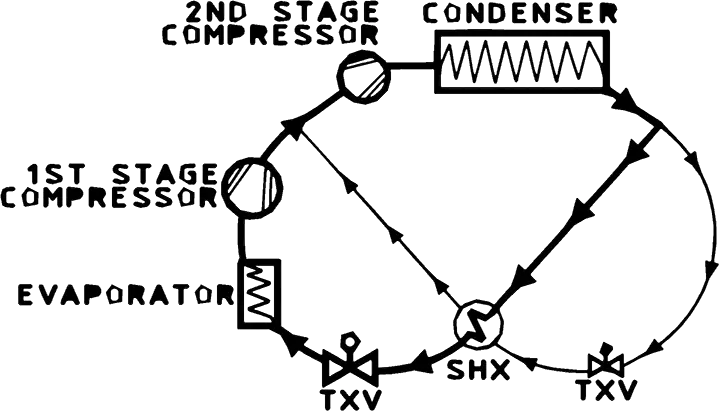Subcooling heating and air may sound like a complex concept, but it’s actually a key factor in maintaining a comfortable home environment. Ever wonder why your HVAC system runs so smoothly and efficiently? Subcooling plays a huge part in that! Stick with us as we dive deep into the world of subcooling and learn how it impacts the comfort of your home.

Table of Contents
Definition of Subcooling
So, what exactly is subcooling? In simple terms, subcooling is the process of cooling a refrigerant below its saturation temperature. This ensures a stable liquid flow and improves the efficiency of your HVAC system. Pretty cool, huh?
The Role of Subcooling in Heating and Air Conditioning
Subcooling plays a vital role in heat transfer and overall system efficiency. It helps increase the performance and lifespan of your heating and air conditioning system. That’s something we all can appreciate, right?
The Refrigeration Cycle
The refrigeration cycle is a closed-loop process that allows your HVAC system to provide heating and cooling. Subcooling is a key player in this cycle, ensuring a smooth and efficient process from start to finish.
Components Involved in Subcooling
Compressor
The compressor is the heart of the subcooling process. It pumps refrigerant throughout the system, ensuring proper circulation. There are various types of compressors, each with its own unique role in subcooling.
Condenser
The condenser is another key player in subcooling. Its job is to dissipate heat and convert the refrigerant from gas to liquid. There are several types of condensers, each designed to maximize efficiency.
Expansion Valve
Meet the expansion valve, the gatekeeper of subcooling. It regulates the flow of refrigerant, ensuring a stable and efficient cooling process. There are a variety of expansion valves available, each with its own unique role in subcooling.
Evaporator
The evaporator is the final piece of the subcooling puzzle. It absorbs heat from your home, turning the refrigerant back into a gas. There are various types of evaporators, each designed to enhance the subcooling process.
Refrigerant
Refrigerant is the lifeblood of the subcooling process. It’s responsible for absorbing and releasing heat, allowing your HVAC system to function properly. There are several common types of refrigerants, each with its own unique properties.
Measuring and Adjusting Subcooling
Tools for Measuring Subcooling
To measure subcooling, you’ll need a few essential tools: a thermometer, a pressure gauge, and a refrigerant scale. These tools will help you accurately measure and adjust your subcooling levels for optimal performance.
Calculating Subcooling
Calculating subcooling is a breeze with the right formula. Simply subtract the measured liquid temperature from the saturation temperature. Let’s walk through an example: if your saturation temperature is 100°F and the measured liquid temperature is 90°F, your subcooling level is 10°F.
Target Subcooling Range
Why is the target subcooling range important? It ensures your HVAC system operates at peak efficiency, resulting in energy savings and improved comfort. Factors like system size, refrigerant type, and climate can all influence the ideal subcooling range for your home.
Adjusting Subcooling Levels
Adjusting subcooling levels is a delicate task. Be sure to follow proper methods and safety precautions, such as using the correct refrigerant and ensuring the system is properly charged. A professional technician can help you fine-tune your subcooling levels for optimal performance.
Troubleshooting Subcooling Issues
Insufficient Subcooling
Insufficient subcooling can be caused by a variety of factors, such as low refrigerant levels, dirty condenser coils, or a malfunctioning expansion valve. These issues can lead to decreased system performance and increased energy consumption. Luckily, solutions like regular maintenance and repairs can help get your subcooling back on track.
Excessive Subcooling
Excessive subcooling can result from an overcharged system, a restricted metering device, or a malfunctioning compressor. This can lead to reduced system efficiency and increased wear and tear on components. Proper diagnosis and repairs can help resolve excessive subcooling issues.
Fluctuating Subcooling Levels
Fluctuating subcooling levels can be caused by air in the system, a failing expansion valve, or a dirty condenser coil. These issues can impact system performance and lead to increased energy consumption. Regular maintenance and repairs can help keep your subcooling levels stable.
Subcooling and Energy Efficiency
The Impact of Subcooling on Energy Consumption
Subcooling directly affects energy usage in your HVAC system. Proper subcooling levels ensure maximum heat transfer and system efficiency, resulting in lower energy consumption and cost savings for you.
Optimizing Subcooling for Energy Efficiency
Want to optimize your subcooling for energy efficiency? Focus on proper system sizing, regular maintenance, and upgrading components when necessary. These steps will help you achieve the perfect balance of comfort and efficiency.
The Future of Subcooling Technology
Advances in Compressor Technology
Compressor technology is constantly evolving, with innovations like variable-speed compressors and magnetic bearing compressors leading the way. These advancements promise increased efficiency and performance in subcooling applications.
Emerging Refrigerants
Environmentally friendly refrigerants and improved performance characteristics are on the horizon. These new refrigerants promise to revolutionize the subcooling process while reducing environmental impact.
Smart HVAC Controls and Subcooling
Integration of IoT devices, remote monitoring, and diagnostics are transforming the world of subcooling. Smart HVAC controls allow for real-time adjustments and system optimization, ensuring your subcooling process is always running at peak efficiency.
Heat Pump Technology
Heat pumps and subcooling go hand in hand. Advancements in heat pump design, such as variable-speed compressors and advanced refrigerants, are enhancing the subcooling process and providing more efficient heating and cooling options for homeowners.
Conclusion
In summary, subcooling is a crucial aspect of heating and air systems, contributing to optimal system performance and energy efficiency. As technology continues to advance, we can expect even more improvements in the world of subcooling. By understanding and maintaining proper subcooling levels, you can ensure a comfortable and energy-efficient home environment for years to come.